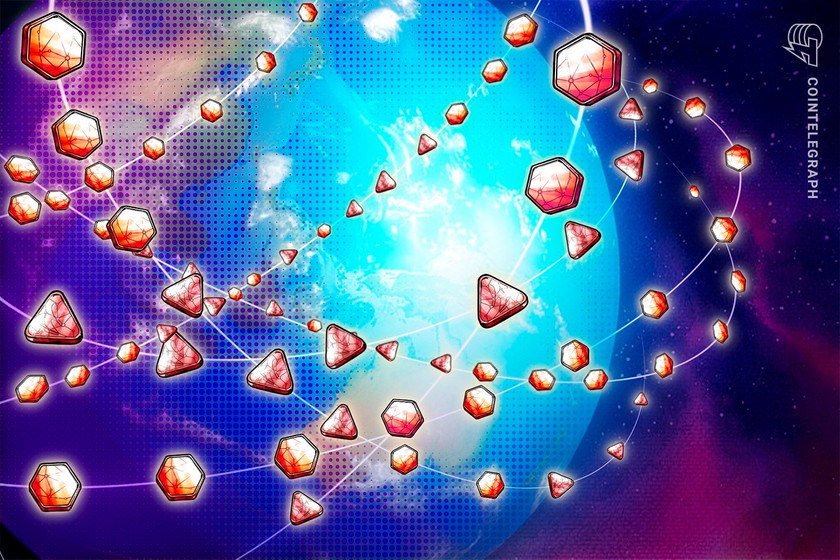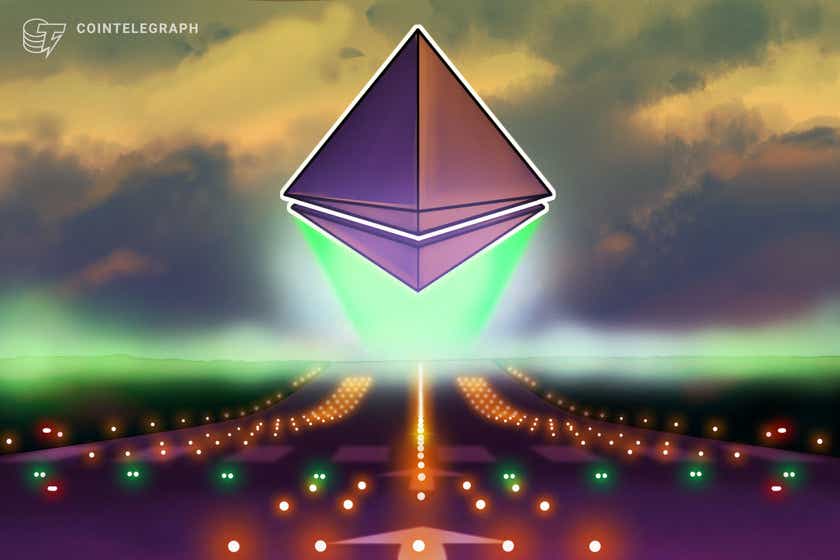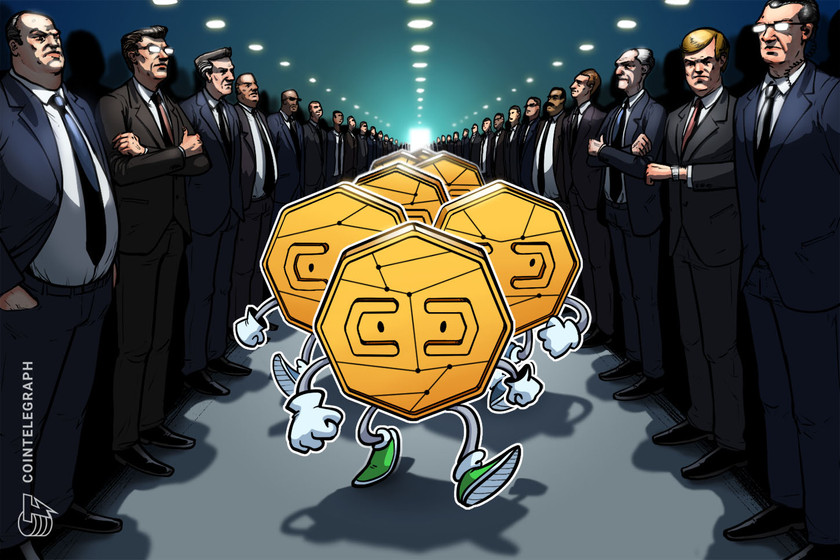Challenging Ethereum 2.0? Competing blockchains are seizing the moment
After several years in development, Ethereum 2.0 is now more tantalizingly close than ever before. Despite a shaky start with the Medalla testnet, it seems that development is still on track. Prysmatic Labs developer Raul Jordan indicated in a recent blog post that “2 to 3 months from the Medalla genesis block is still an ideal timeline.”
At this point, what are another three months? The idea of an upgrade has been floating around in some form since the platform was first launched in 2015. The time it has taken to get this far in implementing Ethereum 2.0 speaks to the fact that it’s far more challenging to change the engine in a moving vehicle than it is to build one from scratch.
Since 2015, many developers have indeed taken the opportunity to build their own engines, most often designed to overcome the same issues that ETH 2.0 is seeking to solve — and more, in some cases. While Ethereum 1.0 blazed a trail, the second version will launch in a now-thriving blockchain scene.
And it’s undoubtedly the case that competition is getting stiffer. When EOS launched in 2018, it didn’t necessarily shape up to be the Ethereum-killer everyone predicted it to be before it launched. But recently, Polkadot has been making progress, with its DOT token now second only to Ethereum in terms of market capitalization for a development-platform coin. As things stand, there is plenty more competition, so how will Ethereum 2.0 shape up against other platforms in solving some of blockchain’s most pressing problems?
Cardano vs. Ethereum 2.0
Cardano has been one of the most hotly anticipated rivals to Ethereum for some time. The platform was developed by one of the original co-founders of Ethereum, mathematician Charles Hoskinson, who left Ethereum in 2014 and subsequently founded IOHK, the company building Cardano.
Cardano has been the subject of many headlines this year as it has launched its latest phase of implementation, known as Shelley, on its mainnet. This has introduced staking to the Cardano network, resulting in significant price action for its ADA token. However, like Ethereum 2.0, Cardano is working on a long-term implementation. Shelley is only the second phase, with three more to come, the next one ushering in smart contracts, with scaling and governance to follow.
In contrast to Ethereum 2.0, Cardano will ultimately operate an on-chain governance model. A representative from Quantstamp, which has been auditing Cardano’s codebase during recent months, previously told Cointelegraph that he believes the project will ultimately dwarf the other major on-chain governance platform, Tezos, becoming second only to Ethereum as the smart-contract platform of choice.
Tezos vs. Ethereum 2.0
Tezos, which launched in 2018, shares a home with Ethereum, given that the foundations behind both projects chose to base themselves in Switzerland’s Crypto Valley. Tezos was developed by Arthur and Kathleen Breitman, although relations between the Breitmans and the Tezos Foundation have been notoriously fraught with infighting.
Tezos operates on a delegated proof-of-stake consensus, which it calls “liquid proof-of-stake.” However, researchers have found that Tezos, while not achieving the same level of decentralization as Ethereum, is more decentralized than many DPoS blockchains. Most likely, this is because Tezos doesn’t impose any upper limit on the number of nodes. Tezos and Ethereum 2.0 can, therefore, certainly compete on security and throughput. The main difference between the two is, perhaps, Tezos’ on-chain governance model.
When the Breitmans conceived of the platform, their vision was for it to be self-maintaining. Similar to what is ultimately planned for Cardano, anyone who meets the minimum staking requirements can vote on protocol upgrades that are then directly implemented once voted through. In contrast, Ethereum governance has always been an off-chain effort and will remain so for the foreseeable future. So far, it would be fair to say that neither model has proven itself inherently superior to the other.
RSK vs. Ethereum 2.0
RSK was launched in late 2017 and caused much excitement around the platform’s promise to bring smart-contract functionality to Bitcoin. Furthermore, with the capacity for many hundreds of transactions per second, it was one of the first real threats to Ethereum in terms of scalability.
RSK is also merge-mined with Bitcoin. Now encompassing up to 48% of the Bitcoin network’s total hashing power, it’s also one of the true rivals to Ethereum in terms of achieving network security through decentralization.
With the backing of parent company IOV Labs, RSK has been making headway in a number of areas. In terms of competition to Ethereum, interoperability and an expansion into the decentralized finance space are the most notable.
Earlier this year, RSK launched an interoperability bridge with Ethereum, enabling anyone to send tokens back and forth between the two platforms, including RSK-based stablecoins and leveraged tokens launched by developer Money on Chain. Diego Gutierrez Zaldivar, CEO of IOV Labs, believes that it’s this interoperability that’s the biggest lever for blockchain adoption, rather than a rivalry approach. He told Cointelegraph:
“We believe that Bitcoin, RSK, Ethereum, and other open blockchains will form a network of networks, the Internet of Value, that will become the financial and social infrastructure of the future. Interoperability is key to ensure blockchain technology antifragility and mass adoption.”
Qtum vs. Ethereum 2.0
Qtum achieved a significant milestone in its roadmap this year with a successful fork to a new version of the mainnet. Similar to what Ethereum 2.0 is currently testing, Qtum runs on a PoS consensus. However, while Ethereum 2.0 staking will require a minimum stake of 32 Ether (ETH), creating a significant barrier to entry, Qtum is striving to ensure that anyone can participate in its staking program.
Most recently, Qtum launched offline staking, making it one of the only platforms that allows users to stake funds that are stored in an offline cold storage wallet. With all staking programs, the biggest rewards come from staking a larger number of tokens; however, there are no minimum staking requirements on Qtum. Jordan Earls, co-founder of Qtum told Cointelegraph:
“We see the shift to proof of stake as validating what we’ve long thought from the beginning on energy, user-friendliness, and security. In addition, we’ve unfortunately seen that the old adage that Proof of Work is inherently more secure than Proof of Stake turns out to be untrue with the increase in 51% attacks on [proof-of-work] chains such as Ethereum Classic. We think this validates our view that proof-of-stake is the future of consensus for the vast majority of non-Bitcoin chains.”
Qtum also runs on the Ethereum Virtual Machine, meaning that the project could potentially benefit from developments in Ethereum 2.0, such as sharding. However, unlike Ethereum, which is restricted to the Solidity programming language for now, developers can write their decentralized applications in a variety of more widely used languages.
Matic Network vs. Ethereum 2.0
As a second layer for Ethereum, Matic Network offers many comparable benefits, such as ERC-20 token compatibility. However, according to the project, it comes with scalability of up to 65,000 transactions per second. The project gained early backing from Binance with a token sale on the exchange’s Launchpad platform for initial exchange offerings and from Coinbase Ventures, which was an early investor. Matic has also partnered with established projects, including Decentraland, to enable high throughput.
So, if Ethereum 2.0 will bring better scalability to the platform, does this mean that second-layer projects such as Matic Network will no longer be required? Sandeep Nailwal, chief operations officer of Matic, doesn’t believe that Ethereum 2.0 will nail the scalability challenge in the same way that Matic has, telling Cointelegraph:
“Ethereum 2.0 doesn’t provide infinite scalability. The best-case scenario is 64 shards, with sharded chains similar to today’s Ethereum chain. Assuming a single chain improves with PoS up to 50 transactions per second, total throughput will still only offer 3200 tps.”
Nailwal believes that the simple fact of Ethereum supplying a higher throughput will drive even greater demand, creating a situation where Ethereum can never scale to the level required by its DApp activity, adding: “First layer blockchains are settlement platforms. They are not meant to support the ’business activity.’” With the craze for DeFi DApps pushing gas fees ever higher, those using second-layer platforms for features like governance votes can avoid the need to move to a competitor platform.
Tron vs. Ethereum 2.0
An early rival to Ethereum, Tron launched in 2017. Under the leadership of Justin Sun, the platform made strides with its acquisition of BitTorrent. In March 2019, Tether announced it was launching a TRC-20 version of USDT. Within six months, Tron-based USDT had grown to 12% of the total coins in circulation, due to Tron’s superior throughput compared with Ethereum.
However, Tron’s scalability comes at a cost, given that the platform is based on a delegated proof-of-stake consensus. In 2019, co-founder Lucien Chen announced he was leaving the project due to the “pseudo-decentralized” nature of Tron, which he believed was counterproductive to the company’s mission to “decentralize the web.” In contrast, Ethereum 2.0 will launch with over 16,000 validators on the Beacon Chain, according to ConsenSys.
Elrond vs. Ethereum 2.0
Elrond is one of Ethereum’s newer competitors, having launched its mainnet in July. In terms of scalability, Ethereum 2.0 will have a hard job keeping up, as the project achieved 260,000 transactions per second on its testnet, thanks to its adaptive state sharding mechanism.
According to Daniel Serb, head of business development at Elrond, the platform’s approach to sharding is comparable with Ethereum 2.0. Both platforms partition the network nodes, transactions and state of the blockchain to achieve high throughput. However, Elrond starts with a fixed number of shards that can process 15,000 transactions per second. However, the protocol allows for the number of shards to increase dynamically, depending on traffic. In contrast, the number of shards on Ethereum is fixed at 64. Developers may find that building on Elrond is more rewarding in the long term in comparison with Ethereum, as Serb told Cointelegraph:
“One of the most attractive features of Elrond is that smart contract authors get 30% of the gas utilized by their contract as royalties, without the caller having to pay more. Elrond smart contracts are upgradeable, which will definitely make life easier for any project’s lifecycle.”
Algorand vs. Ethereum 2.0
Algorand, the brainchild of Turing Award winner and Massachusetts Institute of Technology professor Silvio Micali, launched in 2019. The project claims to be the first to use a “pure proof-of-stake” consensus that ensures network security by making it impossible for the owners of a small fraction of its ALGO tokens to cause any harm.
Perhaps the biggest area in which Algorand can rival Ethereum 2.0 is in development on the platform. Two of the biggest stablecoins issuers, Tether and USD Coin, operate on Algorand. In April, Props Project, a decentralized network of apps, migrated from a private blockchain to Algorand.
Algorand’s head of product, Paul Riegle, recently told Cointelegraph that the project has been sizing up the DeFi space with its latest upgrades, with one of the most intriguing being “rekeying.” Currently, multisignature wallets can be a headache to manage if users want to change an authorized private key holder. Rekeying would allow users to move from a single key to a multisignature to a smart-contract-governed address with a built-in spending policy. Within the DeFi space, this kind of development could make things much easier for DApp operators that take custody of user funds.
Cosmos vs. Ethereum 2.0
Cosmos launched in 2019, causing a stir in the blockchain space as one of the first platforms offering blockchain interoperability. Cosmos was developed by Tendermint, a development company appointed by the nonprofit Interchain Foundation to build a cross-blockchain ecosystem.
With interoperability proving to be a big focus area for blockchain in 2020, Cosmos could be seen as having an edge over Ethereum 2.0. But there’s a unifying theme that unites interoperable blockchain projects: Interoperability is a rising tide lifting all ships. Billy Rennekamp, grants manager at the Interchain Foundation, told Cointelegraph how interoperability benefits Ethereum 2.0 as much as any other platform:
“The ultimate vision is that there should be a large and diverse ecosystem of blockchains, including Ethereum 2.0 that remain composable via Inter-Blockchain Communication (IBC) and together form an Internet of Blockchains, or Interchain. If Eth2.0 utilizes IBC for their cross-shard communication, they will be able to use it for cross-chain communication as well.”
Cosmos also offers scalability through Tendermint’s Byzantine fault tolerance consensus. According to Ethan Buchman, co-founder of Cosmos and CEO of Informal Systems, the classic BFT is arguably the most straightforward and flexible approach to reaching consensus. He told Cointelegraph: “Tendermint’s design decouples the BFT consensus engine from the Proof of Stake economics, allowing more experimentation in the economic details. In contrast, the ETH2.0 consensus is tightly integrated with the rest of the ETH2.0 stack.”
Ardor vs. Ethereum 2.0
Ardor launched in early 2018 and was one of the first platforms to pioneer a multichain architecture running on a proof-of-stake consensus. Ardor runs on a parent and child chain structure, which offers improved throughput compared with a linear blockchain like Bitcoin or Ethereum. This structure can be compared to Ethereum 2.0’s sharding mechanism, where Ethereum’s Beacon Chain will have sharded chains operating as substructures in parallel with one another.
However, Ardor launched with another critical feature built in that is often overlooked by blockchain core developers: Ardor child-chain operators can issue their own native tokens, which are compatible with the parent chain. Lior Yaffe, co-founder and managing director of Jelurida — which operates Ardor and Nxt — told Cointelegraph that: “Ardor’s child chain bundling system enables an application developer to sponsor the transaction fees for its users, and optionally create a hybrid application of permissioned shard secured by a permissionless public chain,” adding that both features are available on the mainnet. Meanwhile, Yaffe remains skeptical about the Ethereum 2.0 implementation timeline: “How and when Ethereum 2.0 will be ready is anyone’s guess.”
No “one blockchain to rule them all”?
So far, while all of these platforms have evident merits, none has yet managed to topple Ethereum in terms of adoption. However, given that the full Ethereum 2.0 implementation could still be at least a year or two away, things could still change.
However, even if Ethereum manages to retain its crown, developments in interoperability and scalability mean there’s every reason to believe that these platforms could survive in the long term.









